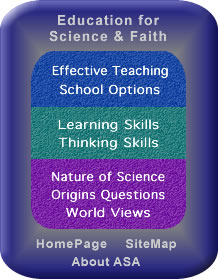This area and its partner — TEACHING
STRATEGIES & TECHNIQUES FOR EFFECTIVE EDUCATION — explore the exciting world
of learning and teaching.
The websites below vary in function. Some provide information,
while others offer activities, or links to websites that have been reviewed
and are recommended by educators. I haven't looked
through everything in these websites, but what I've seen looks good, and
they'll certainly give you plenty of ideas and activities to explore!
For topics that may stimulate interest and motivation (perhaps even
enthusiasm!) for some students:
Science in the Arts — for
the science of Color and Music, Photography, Juggling, and
more;
The Science of Sports — physics,
physiology, nutrition, training, psychology, strategy, equipment, and more,
to help you improve your performance
and pleasure, for a variety of athletic activities;
and from the editor, Aesop's Activities for Goal-Directed
Education that includes Thinking
Skills Education by Teaching
Scientific Method in Labs and in other ways.
Another interesting activity is a "design project" that
is an opportunity for students to solve problems, to invent or improve a
product, or design a strategy for achieving a goal. This is fun, and
the experience will help them learn scientific thinking, since there is a
close relationship between the thinking skills used in science and design,
as explained in An Introduction
to Design. Eventually there will be "design activities" here,
but until then you can use your own creativity to invent ideas for activities.
MORE — The selected web-pages above are only a beginning, since
I haven't yet done a comprehensive search — especially in subject
areas such as biological science, physical sciences, but also for general
thinking
skills — but what is already above will provide lots of interesting ideas for you to
think about. Also, link-pages
that now are more complete will help you explore PUBLIC
SCHOOLS & RELIGION and HOME
SCHOOLS (in the area of School
Options) plus pages about combining
CREATIVE THINKING
and CRITICAL THINKING
into PRODUCTIVE THINKING in PROBLEM-SOLVING
METHODS
(in the area of Thinking Skills).
This home-page for Teaching
Activities (assembled by
Craig Rusbult) is
http://www.asa3.org/ASA/education/teach/activities.htm
All links on this page were checked-and-fixed on December
8, 2008.
